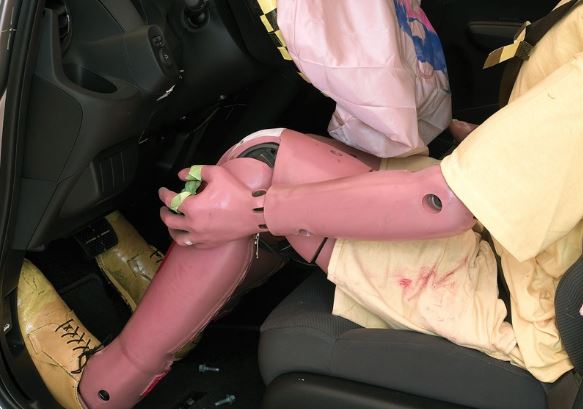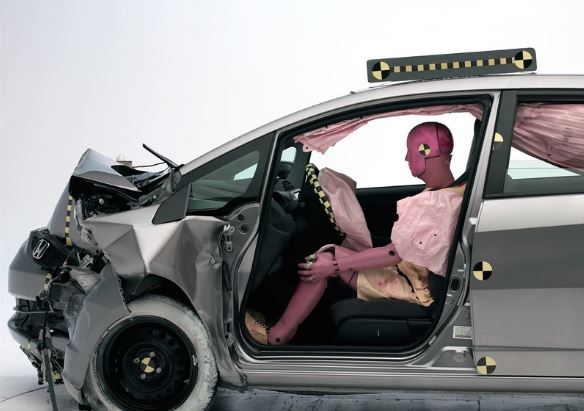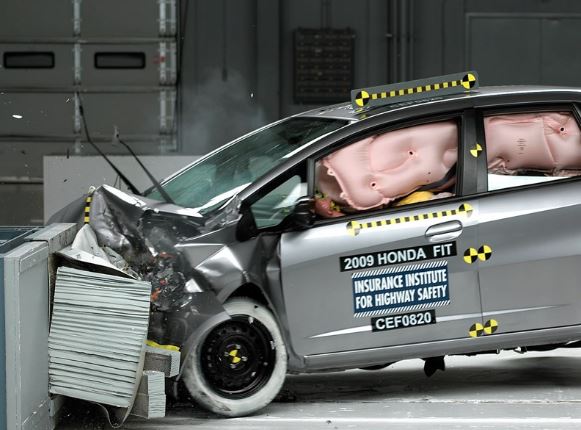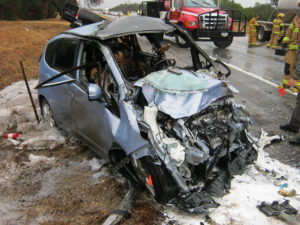
$1M+ lawsuit: Texas body shop’s disregard for Honda repair procedures caused injuries in fiery crash
By onBusiness Practices | Legal | Repair Operations | Technology
A collision repair deviating from Honda repair procedures and absence of a fuel tank cover led to a Texas couple being trapped inside a burning 2010 Fit, a lawsuit demanding more than $1 million alleges.
John Eagle Collision Center’s own manager said the company used structural adhesive to attach the roof in a 2012 hail repair instead of the welds demanded by OEM collision repair procedures. Plaintiff’s engineer Neil Hannemann also reported the absence of the welds Honda says must be done. It was unclear who was responsible for the missing fuel tank cover, Hannemann wrote. (Editor’s note: All highlighting in the hyperlinked documents was done by plaintiff’s counsel.)
“Defendant John Eagle unilaterally chose—on its own—to purposefully ignore Honda’s repair specifications,” the lawsuit states. “Defendant John Eagle made a conscious and deliberate decision to place unsuspecting people in a vehicle that it knew or should have known could cause serious injury or harm if involved in an accident such as occurred in this case. Indeed, John Eagle knew that people could be killed or seriously injured, and deliberately chose to place the Seebachans in danger.
“Such conduct (or lack of conduct) shows a total lack of regard for human life. It also shows a deliberate disregard by Defendants for the safety of persons who would ride in the vehicle at a later date.”
The repair was done for the vehicle’s prior owner, and Matthew and Marcia Seebachan were unaware when they bought the Fit that it had received such body work, according to the couple’s counsel.
The law firm representing John Eagle Collision did not return a message seeking comment. In an answer to the initial version of the lawsuit, John Eagle Collision said some combination of the Seebachans, another party (presumably the other driver) or the accident itself were responsible for what happened. It also argued that the couple’s pre-existing and subsequent conditions and failure to mitigate their situation could be to blame for the outcome.
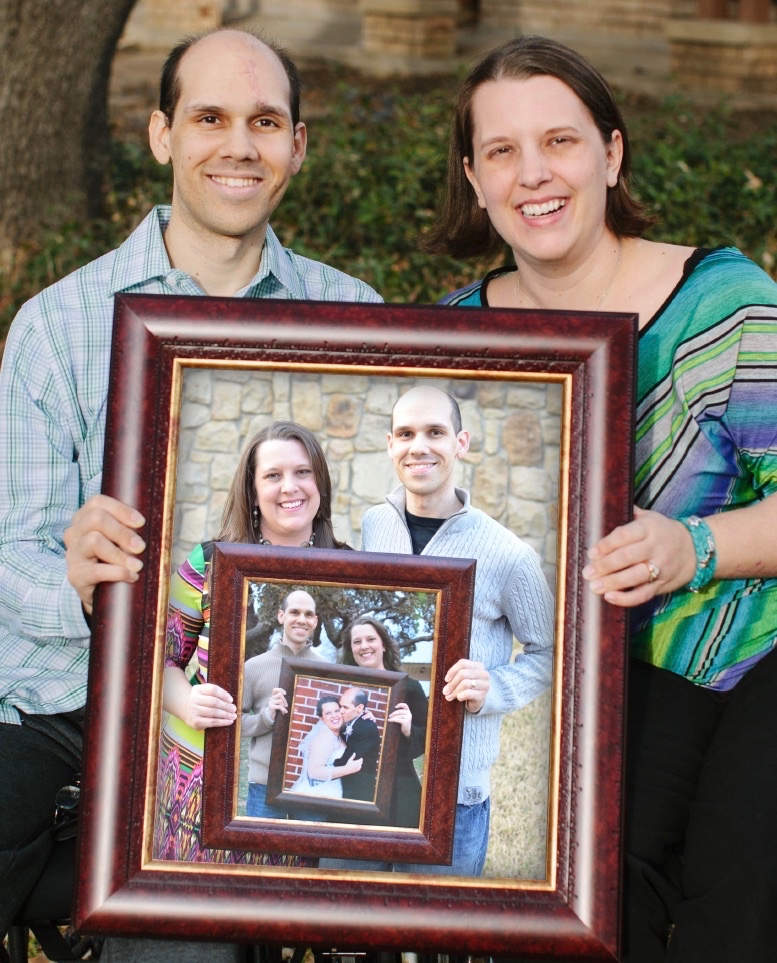
John Eagle Collision was paid more than $8,500 by State Farm for a July 2012 hail repair which included a roof replacement, according to the Tracy Law Firm. Honda OEM repair procedures dictate a shop tack-weld the front and rear corner edges of the new roof and then perform a combination of two- and three-plate spot welds and MIG plug welds.
“There was no way the Seebachans or anyone from Huffines Kia (which sold them the Fit) could see that the roof was glued rather than being welded because paint and shiny trim covered up a time bomb,” attorney Todd Tracy said in a statement. “The testimony and facts in this defective repair lawsuit clearly show that John Eagle Collision Center used glue instead of the more expensive welding because it cares more about getting paid by the insurance company than they care about putting a vehicle out there on the road that’s safe and reliable.”
Asked about the insinuation, State Farm said it had nothing to share.
Body shop director Boyce Willis said in a July deposition that while he wasn’t entirely sure, the shop probably used a 3M 8115 panel bonding adhesive in the 2012 repair. He said John Eagle Collision would have tack welded the roof on as well as part of the shop’s SOP, though he didn’t personally know if that’d been done. Hannemann’s report states that he saw no roof welds at all.
SCRS Education Committee Co-Chairman Toby Chess on Monday observed that structural adhesives have strong tensile strength but low shear strength, which refers to sliding force. He said that’s why mechanical fasteners are often used with them.
Asked who approved the body shop’s use of the structural adhesive in 2012, Willis said the then-director of the body shop did.
“It is — it is a accepted repair alternative, based on our cars and insurance certifications,” Willis said. He also said the I-CAR standard for roof replacements was bonding.
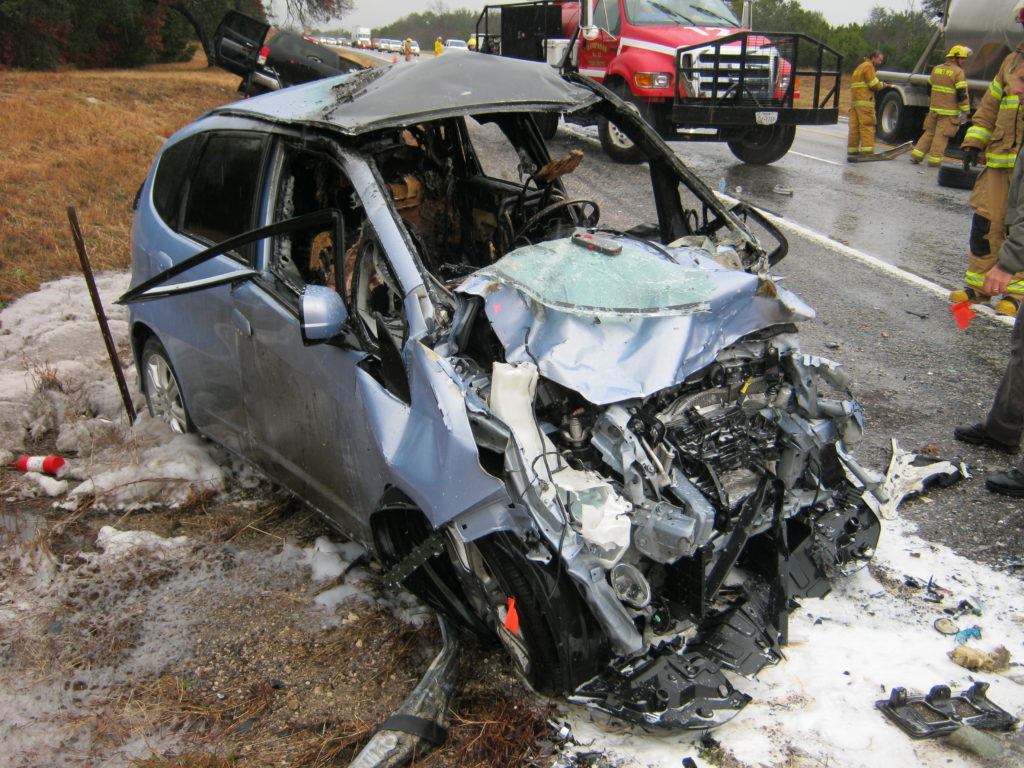
Willis appears to incorrectly describe I-CAR’s standards. The organization’s Uniform Procedures for Collision Repair, dated 1999, list separate procedures for welded roofs and bonded roofs. Both reference having vehicle-specific repair information on hand.
Willis also said that 3M told the shop it was OK to use their adhesives for roofs, but then he acknowledges 3M documents noting that Honda forbids that practice and 3M instructions state to “make required welds on rear vertical seams, cosmetic joints, or where otherwise recommended by the directions for use or the OE manufacturer.”
Wills insisted in the deposition that using structural adhesive was better than welding, while acknowledging that he has no testing to support that hypothesis other than observing cars in his shop and how other OEMs like Aston Martin say their vehicles should be replaced.
“It’s cleaner; it’s less intrusive to the vehicle. Keep in mind, it’s a — it’s a panel. It’s not a structural piece; it’s a panel,” Willis said, according to the transcript.
“John Eagle Collision Center repairs almost 5,000 vehicles a year in Dallas alone not counting their Houston Collision Center,” Tracy said in a statement. “It is a billion dollar a year Texas car dealer giant that apparently is not following the manufacturer’s repair recommendations. In this case, the insurance company paid John Eagle $8500 to make a repair that was not up to manufacturer standards.”
Crash performance
The roof is structural on the unibody Fit, according to Hannemann — a former chief engineer for the Ford GT who was responsible for its crash performance.
Hannemann said that in his expert opinion, the failure of the roof during the crash compromised the overall structure and collision energy management of the vehicle — contributing to Matthew and Marcia Seebachan being trapped inside and the subsequesent fire. Both of the Fit’s lower frame rails detached, one of them striking the fuel tank located under the driver and passenger, he wrote.
“It can be seen that no welds are present,” Hannemann wrote. “The (Z-)buckling of the cant rail is due to the lack of welding of the roof panel, which was designed to be welded on and acting as a shear panel for sharing crash loads.”
North Dakota State University Impact Biomechanical Laboratory director Mariusz Ziejewski concurred in an assessment evaluating how the crash resulted in injuries to the couple. The unibody car failed to properly distribute the energy around the couple, crushed their legs and trapped them inside the burning car, he wrote.
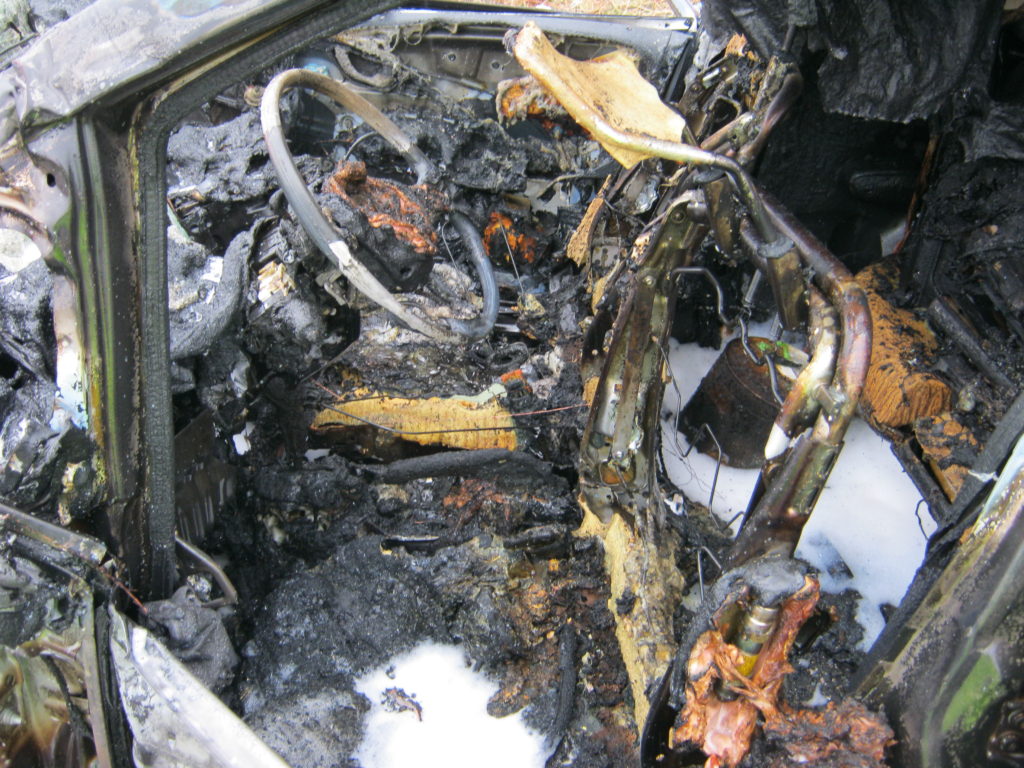
“Trapped behind the steering wheel, Matthew Seebachan remained conscious as flames fried his feet and lower legs before he was pulled from the wreckage by a motorist,” Tracy Law Firm wrote in a news release. “Another motorist rescued his wife Marcia through the passenger window of the mangled car.”
The 2010 Honda Fit has a “poor” Insurance Institute for Highway Safety 40 mph small-overlap crash test rating but a “good” 40 mph moderate-overlap crash-test rating.
“The 2010 Honda Fit was originally designed to provide structural and fuel system crashworthiness protection, which would prevent serious injuries to occupants in this foreseeable accident,” Hannemann wrote. “In fact, the 2010 Honda Fit receives the highest rating from the IIHS for the moderate offset impact test, which is virtually identical in terms of crash forces to the subject accident.”
A 2010 Toyota Tundra had hydroplaned into the Seebachans’ oncoming Fit on a 75 mph stretch of road, and the Fit struck the right front quarter of the Tundra. Two of the Tundra’s occupants were uninjured, while the other was merely bruised. The Seebachans were seriously injured.
“This accident should have been survived with only minor injuries,” Hannemann wrote. “The occupants of the Toyota that had lost control and was stuck in the side by the Honda Fit survived with no injuries, or just a bruise in one case. In a ‘T-bone’ type of accident, the vehicle struck in the side typically has worse injuries that the vehicle that is impacted on the front. In this case, the reverse occurred. This is an indication of the defective roof repair affected many of the safety systems of the Honda Fit. The Seebachan’s would likely have had only minor injuries if not for the faulty repair. One must remember that a vehicle’s safety systems are like links in a chain. Each system must work together to ensure the other safety systems perform as designed. When the faulty structural repairs were made, the crashworthiness systems were all compromised.”
“Due to the roof’s lack of proper welding, the entire structural system of the 2010 Honda Fit was compromised, including the A-pillar, toeboard, footwell, and floorpan which allowed excessive intrusion into the survival space of the driver and front seated occupant,” Ziejewski wrote. “Mr. and Mrs. Seebachan’s torso injuries, upper extremity fractures, Mr. Seebachan’s facial laceration, and Mrs. Seebachan’s inner organ injuries are consistent with their bodies impacting and being crushed by the intruding components. The intruding footwell most likely was the injury mechanism of their lower extremity fractures, with entrapment preventing immediate escape thus causing them to sustain burn injuries.”
The glued roof also produced an inability to open the doors — something that should have been possible had the Fit’s crashworthiness been restored by the body shop, according to Hannemann. (Acura showed a similar point with its 2015 comparison of a factory MDX after a crash and an improperly sectioned MDX after a crash — the doors on the botched one were stuck.)
“Mr. and Mrs. Seebachan were thrown forward and to the left impacting the intruding vehicle’s structures, and consequently trapped by the jammed doors and intruding footwell,” Ziejewski wrote. “The fire then caused enhanced injuries due to entrapment.
“Conclusion: Had the roof been properly welded by Mr. John Eagle Collision, the vehicle’s structure would have been able to appropriately distribute the impact energy and maintain the occupants’ survival space. Had the survival space been maintained, Mr. and Mrs. Seebachan’s injuries would not have been as severe, they would not have been trapped within their vehicle, and most likely their vehicle would not have caught fire.” (Emphasis Ziejewski’s.)
Hannemann makes an important argument that a used-vehicle owner should be able to expect the same collision protection as a new-car buyer.
“The defendants’ may suggest that pre-owned buyers are not entitled to the same degree of safety as the original owner,” he wrote. “While the vehicle may be used, have mileage and age, creating wear and tear, this should not affect the important safety systems. These systems do not ‘wear out’ like engines, transaxles, suspension, etc. The safety systems should be designed for the ‘life of the vehicle’. The vehicle structure also does not ‘wear out’, it should maintain its integrity and function for the life of the vehicle. Safety is not related to the age of a vehicle.”
The Seebachans originally sued the Kia dealership which sold them the Fit; Hanneman’s report argues the company should have been more aware of the Fit’s condition. They’ve since removed the dealership as a defendant and dropped the case against it for good.
More information:
Tracy Law Firm via PR Newswire, July 24, 2017
Honda OEM repair procedures portal on OEM1Stop
Images:
This 2010 Honda Fit burned following a collision with a hydroplaning 2010 Toyota Tundra. (Provided by Tracy Law Firm via PRNewsFoto)
Matthew and Marcia Seebachan were seriously injured after their 2010 Honda Fit collided with a hydroplaning 2010 Toyota Tundra. (Provided by Tracy Law Firm via PRNewsFoto)
An Insurance Institute for HIghway Safety moderate-overlap crash test of a 2009-13 Honda Fit. (Provided by IIHS)
Little intrusion occurred during an Insurance Institute for HIghway Safety moderate-overlap crash test of a 2009-13 Honda Fit. (Provided by IIHS)

